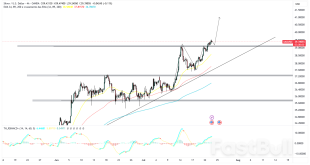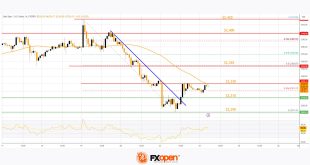Gold, a precious metal revered for centuries, holds a unique position in the global economy. Its price fluctuations can significantly impact investment portfolios, national economies, and even international relations. Consequently, understanding how Wall Street analysts predict gold prices is crucial for investors, policymakers, and anyone seeking financial stability. Seriously, who doesn’t want a little financial stability? This article delves into the methodologies, factors, and challenges involved in forecasting the often-unpredictable movements of the gold market. Think of it as your crash course in ‘Gold Price Prediction 101,’ without the pop quizzes.
Understanding the Factors Influencing Gold Prices
Okay, so you wanna know where gold’s head is at, right? Well, it’s not as simple as asking. Gold’s price is like a moody teenager – influenced by a whole bunch of stuff. We’re talking global economics, crazy world events, and the general vibe of investors. Let’s break it down, shall we?
Global Economic Conditions
First up, the big picture stuff. The overall health of the world economy has a HUGE impact. You can almost feel it in the air, can’t you? When things are looking shaky, people tend to run to gold as a safe haven. Kinda like hiding under the covers when you hear a scary noise. Makes you feel better, even if it doesn’t actually do anything.
Interest Rates: So, low interest rates? Good for gold. High interest rates? Not so much. Why? Because when interest rates are low, holding gold looks more attractive than holding interest-bearing assets. It’s all about opportunity cost, baby.
Inflation: Ah, inflation, that sneaky thief stealing your purchasing power. Gold is often seen as an inflation hedge. When inflation goes up, so does the demand (and price) for gold. It’s like everyone’s buying an umbrella when it starts to rain. Does it really help that much? Debatable. But it feels like it does.
Economic Growth: You’d think strong economic growth would be good for everything, right? Well, it depends. Sometimes, strong growth means less demand for safe havens like gold. People are feeling good, taking risks! But sometimes, it can also boost demand for gold in industries like jewelry. It’s a mixed bag.
Geopolitical Events
Let’s face it, the world’s a bit of a mess right now. And when things get dicey on the global stage, gold tends to shine. It’s like the ultimate “flight to safety.” Think of it as the financial equivalent of bugging out to your cabin in the woods (if you had one, that is).
Political Instability: Wars, coups, political meltdowns… these things send shivers down investors’ spines and send gold prices soaring. It’s all about fear, really. Fear sells (or buys) gold.
*
Currency Fluctuations: If a major currency like the dollar takes a nosedive, gold often becomes more attractive as an alternative store of value. It’s like diversifying your portfolio, but instead of stocks and bonds, it’s currencies and shiny rocks. Okay, maybe that’s an oversimplification.
Trade Wars: Remember the whole US-China trade war thing? Uncertainty about trade and tariffs can drive investors towards gold. Nobody likes uncertainty. Except maybe chaos theorists.
Market Sentiment and Investor Behavior
This is where it gets a little… psychological. Gold prices aren’t just about hard numbers; they’re about feelings. Investor confidence, fear, greed… it all plays a role. Ever get that gut feeling that something’s about to happen in the market? That’s market sentiment at work.
Speculative Trading: Day traders, hedge funds, and other speculators can jump in and out of the gold market, causing short-term price swings. It’s kinda like a school of fish suddenly changing direction. Why? Who knows! But everyone follows.
*
Investor Confidence: When investors are feeling nervous, they flock to gold. When they’re feeling confident, they might chase higher-risk assets. It’s a constant tug-of-war between fear and greed. And honestly, it’s hard to predict which will win out on any given day.
Exchange-Traded Funds (ETFs): Gold ETFs hold massive amounts of physical gold. When these ETFs buy or sell, it can significantly impact prices. It’s like a whale entering or leaving a swimming pool – everyone notices.
Methodologies Used by Wall Street Analysts
Alright, so how do the big guns on Wall Street actually predict these movements? They use a bunch of tools and techniques, some more reliable than others. Think of it as trying to predict the weather – you can use radar, historical data, and even look at the woolly worms, but you’re still never 100% sure it’s gonna rain.
Technical Analysis
This is all about charts, patterns, and past price movements. It’s like reading tea leaves, but with fancy computer software. Some people swear by it; others think it’s a load of hooey. Personally, I’m on the fence.
Chart Patterns: Head and shoulders, double tops, flags… these patterns are supposed to indicate future price movements. If you stare at them long enough, you might start seeing things. Or maybe that’s just me.
*
Moving Averages: Smoothing out price data to identify trends. It’s like putting on your glasses to see the bigger picture. Except sometimes, the bigger picture is still blurry.
Relative Strength Index (RSI): Measuring how overbought or oversold gold is. Basically, is it due for a correction? Or is it just getting started? Good question!
Fundamental Analysis
This approach looks at the underlying factors that influence gold prices, like supply and demand, production costs, and central bank policies. It’s like trying to understand the engine that’s driving the car, rather than just looking at the speedometer.
Supply and Demand: Basic economics, folks. When demand exceeds supply, prices go up. When supply exceeds demand, prices go down. Seems simple, right? Except figuring out the exact levels of supply and demand is anything but simple.
Production Costs: How much does it cost to mine gold? If production costs rise, that puts upward pressure on prices. Think of it as the price of making a pizza – if the ingredients get more expensive, so does the slice.
Central Bank Policies: Central banks hold massive gold reserves and their buying and selling activity can have a big impact. Plus, their interest rate decisions influence investor sentiment. They’re like the puppet masters of the financial world… or at least, they’d like to be.
Econometric Modeling
This is where things get seriously geeky. Econometric models use statistical techniques to forecast prices based on historical data and macroeconomic variables. It’s like trying to predict the future using a super-powered spreadsheet. Does it work? Sometimes. But don’t bet your life savings on it.
*
Regression Analysis: Using statistical models to find relationships between gold prices and other variables. It’s like trying to find the secret sauce that makes everything tick.
*
Time Series Analysis: Analyzing historical data to identify trends and patterns. It’s like looking at the rings of a tree to understand its history. Cool, but not always predictive of the future.
Incorporating Macroeconomic Variables: Throwing everything into the model – GDP, unemployment, inflation, interest rates… the kitchen sink! The more variables, the more complex the model, and the more likely it is to break down. Just sayin’.
Challenges in Predicting Gold Prices
Here’s the truth: predicting gold prices is HARD. Really hard. There are so many factors at play, and the market is so volatile, that even the smartest analysts get it wrong sometimes. It’s like trying to catch a greased pig at a county fair – slippery and unpredictable.
Market Volatility
Gold prices can swing wildly in response to unexpected events, making it difficult to predict future movements. It’s like trying to steer a boat in a hurricane.
Unforeseen Events: A surprise interest rate hike, a political crisis, a natural disaster… these things can throw all the models out the window. Seriously, who saw that coming?
*
Behavioral Biases: Analysts are human, and humans are prone to biases. Confirmation bias, anchoring bias, herding behavior… these can all cloud judgment. Nobody’s perfect, right?
Data Limitations: The data used to build these models isn’t always complete or reliable. Garbage in, garbage out, as they say.
Complexity of Interacting Factors
It’s not just about individual factors; it’s about how they interact with each other. It’s like a complex ecosystem, where everything is connected. Change one thing, and everything else changes too.
Multiple Variables: Managing the influence of numerous factors makes forecasting a Herculean task. How do you weigh the relative importance of each variable? Good luck with that!
Non-Linear Relationships: The relationship between gold prices and other factors isn’t always linear. Sometimes, a small change in one variable can have a huge impact on gold prices. And sometimes, it has no impact at all.
Feedback Loops: Changes in gold prices can themselves influence the factors that drive those prices. It’s a circular relationship that can be difficult to unravel. Imagine trying to untangle a ball of yarn that’s also trying to untangle you.
The “Black Swan” Effect
This refers to highly improbable events that have a massive impact on the market. Think of the 2008 financial crisis or the COVID-19 pandemic. These things are impossible to predict, but they can completely upend the gold market. They are the nightmares of every analyst!
*
Unpredictable Events: These events defy prediction and can have devastating consequences for forecasts. You just can’t see them coming.
*
Managing Uncertainty: Develop strategies for dealing with uncertainty, such as diversification and hedging. Don’t put all your eggs in one golden basket.
*
Scenario Planning: Prepare for different possible outcomes. What if inflation spikes? What if there’s a major war? What if aliens land on Earth and demand all our gold? Okay, maybe that last one’s a bit far-fetched.
Ultimately, deciphering how Wall Street analysts attempt to predict gold prices isn’t a simple task; it’s a fascinating blend of art and science, influenced by a myriad of factors and fraught with challenges. While these sophisticated techniques and models can offer valuable insights into potential market movements, the inherent unpredictability of the gold market means that no forecast is ever a sure thing. So, invest wisely, stay informed, and maybe keep a rabbit’s foot handy. You never know when you might need it! And hey, feel free to share your own gold price predictions, or any interesting theories you have. I’m always up for a good financial conspiracy!
 seeme
seeme




